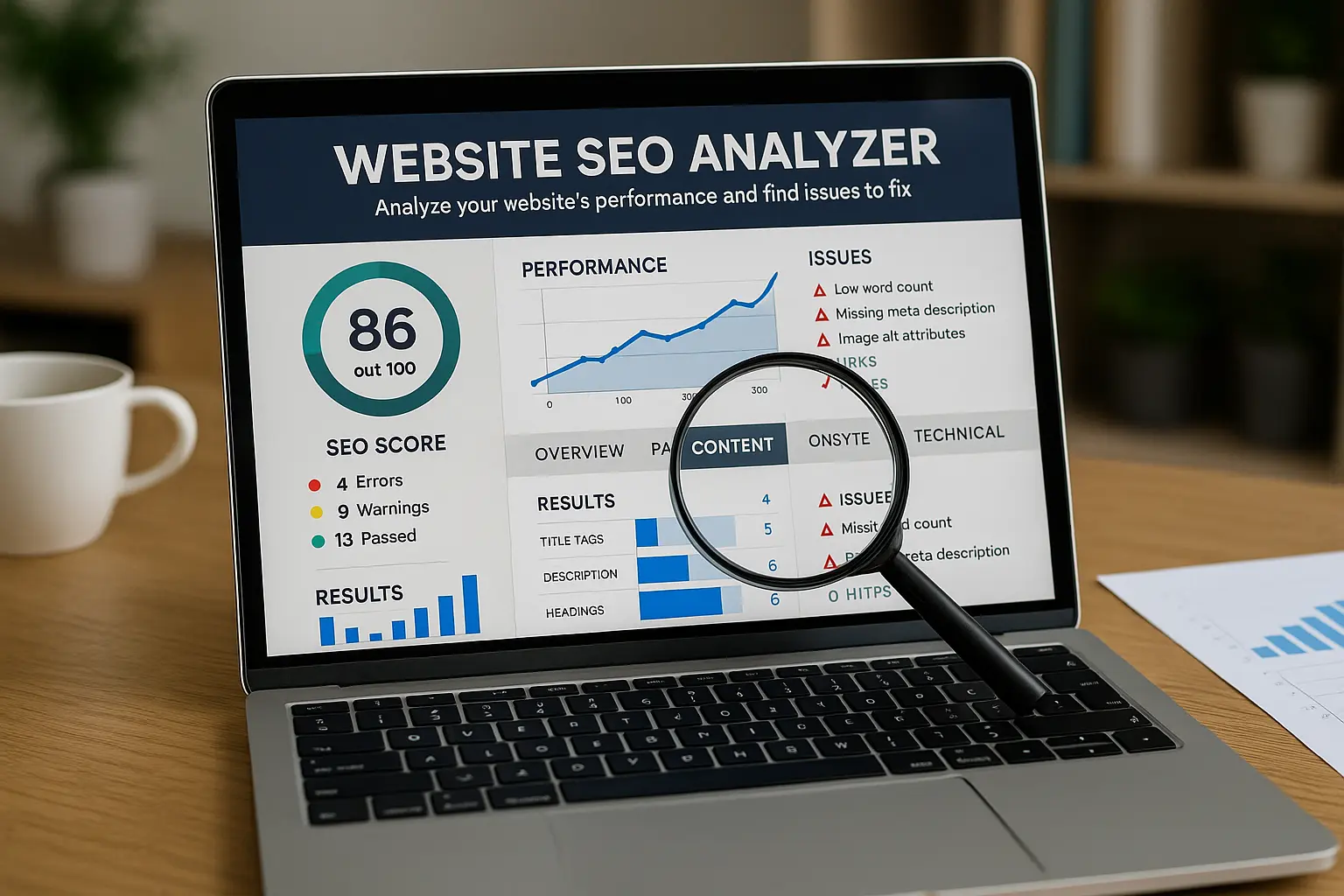This comprehensive blog explores how a website SEO analyzer helps businesses optimize site health, improve search rankings, and stay competitive. It covers SEO audit essentials, key features of top tools, and integration strategies to drive higher visibility in search engine results. Includes expert tips, FAQs, and useful links.
Website SEO Analyzer: How to Audit and Optimize Your Site for Google Rankings
Website SEO Analyzer: Optimize Your Website with Precision
What is a Website SEO Analyzer?
A website SEO analyzer is a digital tool that audits your website’s performance in search engines. It identifies technical, on-page, and off-page SEO issues that may prevent your site from ranking well on Google.
Popular features of SEO analyzers include:
- Meta tag analysis
- URL structure checks
- Page speed metrics
- Broken link reports
- Mobile-friendliness assessments
These tools help you monitor and improve SEO performance for higher visibility and better user experience.
Why You Need SEO Analysis
SEO analysis isn’t just about ranking higher—it’s about:
- Improving user experience through faster and more mobile-friendly pages
- Increasing organic traffic with targeted content suggestions
- Ensuring technical compliance with Google’s best practices
- Fixing visibility blockers like crawl errors, duplicate content, and thin content
Regular analysis with an SEO tool ensures you’re not losing potential traffic due to overlooked technical issues.
Key Features of a Good SEO Analyzer
Not all tools are created equal. A powerful SEO analyzer should include:
1. Technical SEO Audit
Crawls your entire site and identifies errors like:
- 404 pages
- Redirect chains
- Sitemap issues
- Robots.txt conflicts
2. On-Page SEO Checker
Scans each URL for:
- Meta titles and descriptions
- Header tags
- Keyword usage
Internal linking
3. Backlink and Authority Monitoring
Monitors backlinks, anchor texts, and domain authority.
4. Page Speed Testing
Audits speed performance on desktop and mobile.
5. Mobile Optimization
Checks Core Web Vitals and responsiveness.
How to Use an SEO Analyzer Tool
Most analyzers are beginner-friendly. Here’s how you can use one:
Step 1 – Enter Your URL
Paste your website URL into the SEO tool dashboard.
Step 2 – Choose Scan Depth
Some tools allow full or limited scans. Choose based on site size.
Step 3 – Review the SEO Score
Get a detailed breakdown of what’s working and what’s not.
Step 4 – Fix Issues
Follow the recommendations provided—most tools offer clear instructions or links to guides.
Step 5 – Re-scan
After making fixes, run another scan to track improvements.
Growvilo SEO Services
If you’re unsure how to implement technical fixes, consider expert help from Growvilo.
Growvilo provides tailored SEO audits and services for businesses:
- Complete site diagnostics
- Competitor benchmarking
- Keyword optimization
- Technical cleanup
You can contact their team at Growvilo or explore more at Growvilo
Top Free and Paid SEO Analyzers
Here’s a quick overview of top tools:
| Tool Name | Free Plan | Best For |
| Ahrefs | Yes | Backlinks, Site Audit |
| SEMrush | No | Comprehensive SEO |
| Ubersuggest | Yes | Beginner SEO |
| Screaming Frog | Yes | Technical site crawls |
| Google Search Console | Yes | Indexing and Core Web Vitals |
Common SEO Errors and Fixes
Here are the most common SEO issues and how to solve them:
| Error | Solution |
| Duplicate Meta Descriptions | Write unique meta for each page |
| Broken Links | Use 301 redirects or remove them |
| Missing Alt Text | Add alt attributes to all images |
| Slow Loading Pages | Compress images, use CDN |
| Thin Content | Expand content to match search intent |
How to Interpret Your SEO Report
Look for these high-priority metrics in your report:
- SEO Score: Overall rating (usually out of 100)
- Page-Level Health: Individual page analysis
- Fix Urgency: Items marked as critical should be addressed first
- Keyword Insights: Relevance and density for target keywords
- Mobile Score: UX and speed insights on mobile devices
Integrating Insights into Strategy
SEO tools only provide data. What you do with the insights matters most.
1. Create a Fix Calendar
List all issues and prioritize by impact. Create a weekly roadmap.
2. Content Planning
Use keyword suggestions from the analyzer to create content that fills gaps.
3. Link Building
Identify weak internal linking structures and build contextual links.
4. Technical Maintenance
Schedule monthly scans to maintain long-term SEO health.
5. Competitor Benchmarking
Many SEO tools let you compare your site to competitors. Use this to identify untapped opportunities.
Frequently Asked Questions
1. How often should I use an SEO analyzer?
Ideally, every month or after a major site update.
2. Can I trust free SEO tools?
Yes, but they may have limited features. Use them for quick audits and pair them with manual checks or paid tools.
3. What’s a good SEO score?
A score of 85+ is considered healthy, but focus on resolving red-flag issues.
4. Do SEO analyzers check for mobile-friendliness?
Yes, most include mobile UX and Core Web Vitals in their reports.
5. Can I optimize my site without an SEO expert?
Basic fixes can be done solo. For deep technical audits, consult experts like Growvilo
Conclusion
A website SEO analyzer is an essential tool for every business aiming for better visibility on search engines. It helps you detect weaknesses in your technical setup, on-page structure, content, and user experience—everything Google considers important.
With the right analyzer, you gain a roadmap to climb SERP rankings without guesswork. Whether you’re a startup or an established brand, SEO audits will boost your online performance.
Ready to level up your SEO game? Start with a free tool or contact Growvilo to get a personalized audit from industry experts.



